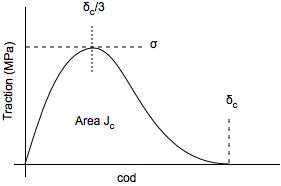Difference between revisions of "Cubic Traction Law"
| Line 8: | Line 8: | ||
| | ||
<math>\sigma = {27\over 4}\sigma_{max} {\delta\over\delta_c}\left(1-{\delta\over\delta_c}\right)^2</math> | <math>\sigma = {27\over 4}\sigma_{max} {\delta\over\delta_c}\left(1-{\delta\over\delta_c}\right)^2</math> | ||
There are separate traction laws for opening displacement (mode I) and sliding displacement (mode II). | There are separate traction laws for opening displacement (mode I) and sliding displacement (mode II). | ||
The toughness of this traction law is the area under the curve or: | |||
| |||
<math>J_c = {9\over 16} \sigma\delta_c</math> | |||
When creating this traction law, you have to enter exactly two of these failure properties for both mode I and mode II (''i.e.'', two of J<sub>Ic</sub>, σ<sub>I</sub>, and δ<sub>Ic</sub> and two of J<sub>IIc</sub>, σ<sub>II</sub>, and δ<sub>IIc</sub>). Whichever property is not specified will be calculated from the two provided properties using one of the following relations: | |||
| |||
<math>\delta_c = {16J_c\over 9000\sigma}, \qquad \sigma = {16J_c\over 9000\delta_c}, \qquad {\rm or} \qquad J_c = {\over 16}\sigma\delta_c</math> | |||
These relations assume J<sub>Ic</sub> in J/m<sup>2</sup>, σ in MPa, and δ<sub>c</sub> in mm. | |||
== Failure == | == Failure == | ||
Revision as of 13:11, 7 January 2014
The Traction Law
This traction law assumes use a cubic function for traction as a function of crack opending displacement (COD). This cubic relation is choosen such that the slope is zero at δc and the peak always occurs at δc. This traction law was first proposed by Needleman. It has a convenient smooth shape for numerical calculations and the zero slope at δc may be desirable. There is no physical basis to claim it is more realistic than other traction laws. The resulting function is
[math]\displaystyle{ \sigma = {27\over 4}\sigma_{max} {\delta\over\delta_c}\left(1-{\delta\over\delta_c}\right)^2 }[/math]
There are separate traction laws for opening displacement (mode I) and sliding displacement (mode II).
The toughness of this traction law is the area under the curve or:
[math]\displaystyle{ J_c = {9\over 16} \sigma\delta_c }[/math]
When creating this traction law, you have to enter exactly two of these failure properties for both mode I and mode II (i.e., two of JIc, σI, and δIc and two of JIIc, σII, and δIIc). Whichever property is not specified will be calculated from the two provided properties using one of the following relations:
[math]\displaystyle{ \delta_c = {16J_c\over 9000\sigma}, \qquad \sigma = {16J_c\over 9000\delta_c}, \qquad {\rm or} \qquad J_c = {\over 16}\sigma\delta_c }[/math]
These relations assume JIc in J/m2, σ in MPa, and δc in mm.
Failure
Traction Law Properties
The following properties are used to create a triangular traction law:
| Property | Description | Units | Default |
|---|---|---|---|
| (other) | Properties common to all traction laws | varies | varies |
